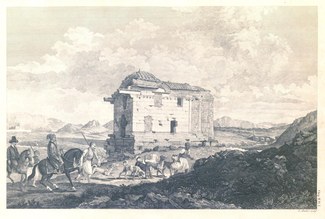Antiquarian volumes in the ISAW Library collection
Among the rare books now in ISAW’s collection are 17th, 18th and 19th century editions of:
- the works of Polybius once owned by the noted Hellenistic historian Frank Walbank;
- books on Greek history and Roman law from the collection of the historian C. R. Whittaker; and
- a selection of 18th-century editions of classical literary texts from the library of archaeologist Paul Åström.
The bulk of the antiquarian books come from the collection of Cornelius and Emily Vermeule, including a number of early illustrated volumes reporting on antiquities surveyed in the 18th and 19th centuries. These volumes illustrate—often with elaborate engravings—a grand period of rediscovery.
Among the books from the Vermeule collection are several important works issued by the Society of Dilettanti. This organization was founded in 1734 as a gentlemen’s dining club, but by the second half of the century had become an important sponsor of research. As described in the introduction to the Society’s two-volume Ionian Antiquities:
Upon a Report of the State of the Society's Finances in the year 1764, it appeared that they were possessed of a Considerable Sum above their current Services required. Various Schemes were proposed for applying part of this Money to some Purpose ; which might promote Taste, and do Honour to the Society, and after some Consideration it was resolved “That a Person or Persons properly qualified should be sent, with sufficient Appointments to certain Parts of the East, to collect Informations relative to the former State of those countries, and particularly to procure exact descriptions of the Ruins of such Monuments of Antiquity as are yet to be seen in those Parts."[1]
 The Society of Dilettanti sponsored two major expeditions: James Stuart and Nicholas Revett’s survey of Athenian sites and Richard Chandler’s expedition to Ionia. The findings of these expeditions were published in the late 18th and early 19th century as large folios with elaborate and detailed engravings. The volumes proved a vital source of inspiration to English and American architectural classicism, as well as providing valuable illustrations of several sites that have since been destroyed. For example, a small Ionic temple illustrated in the first volume of Stuart and Revett’s Antiquities of Athens was demolished in 1778, its stones used by the Ottoman Turks for new fortifications around Athens. The eight pages of meticulously-measured illustrations in the Dilettanti volume are all that survive to show the original structure.
The Society of Dilettanti sponsored two major expeditions: James Stuart and Nicholas Revett’s survey of Athenian sites and Richard Chandler’s expedition to Ionia. The findings of these expeditions were published in the late 18th and early 19th century as large folios with elaborate and detailed engravings. The volumes proved a vital source of inspiration to English and American architectural classicism, as well as providing valuable illustrations of several sites that have since been destroyed. For example, a small Ionic temple illustrated in the first volume of Stuart and Revett’s Antiquities of Athens was demolished in 1778, its stones used by the Ottoman Turks for new fortifications around Athens. The eight pages of meticulously-measured illustrations in the Dilettanti volume are all that survive to show the original structure.
The illustrations in the Dilettanti volumes show not only the ruins as they were when they were surveyed in the 18th century, but also their environs, including local costumes and wildlife. For instance, Stuart and Revett’s illustration of the Gate of Athena Archegetis, also in the first volume of Antiquities of Athens, shows a bustling street scene around the Doric portico, complete with Turkish, Greek, and French pedestrians in period garb; an Ottoman horseman with his hunting dogs; and birds nesting among the ruins. Most of the structures pictured in the area of the gate are no longer extant. In addition to these idyllic scenes, each site is illustrated with numerous, more technical plates, reproducing the finer architectural details of columns and entablatures with diligent exactitude.
The staff of the ISAW Library is currently devising a plan for the antiquarian volumes in its collection. It is our hope that the majority of them will find a permanent home in the Oak Library on the second floor. However, some of the volumes require conservation, and others—including the Society of Dilettanti volumes—are larger than we can currently accommodate. Some, including a 1778 Russian-language history of the Incas, are simply out of scope for our collection. Many of these materials will be given to NYU’s Fales Library and Special Collections.
In the coming months, we will periodically highlight particularly interesting volumes from the collection on our blog. To see any of the books themselves, inquire at our circulation desk.
![“Doric Portico at Athens [Gate of Athena Archegetis].” Stuart and Revett. Antiquities of Athens, vol. 1, chap. 1, pl. 1.](https://isaw.nyu.edu/library/images/AthenaArchegetis1.jpg/@@images/efdd6227-440b-4949-8462-a651751d2892.jpeg)

[1] R. Chandler, N. Revett, and W. Pars, Ionian Antiquities [vol. 1]. London: Society of Dilettanti, 1769, p. ii.